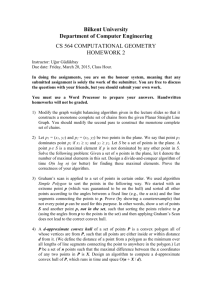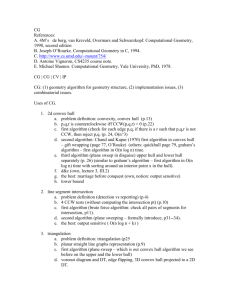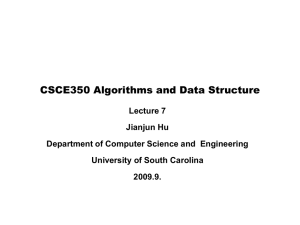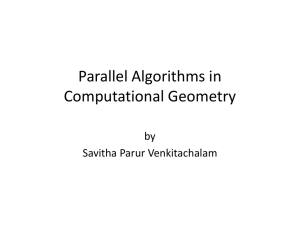Slide 2
advertisement
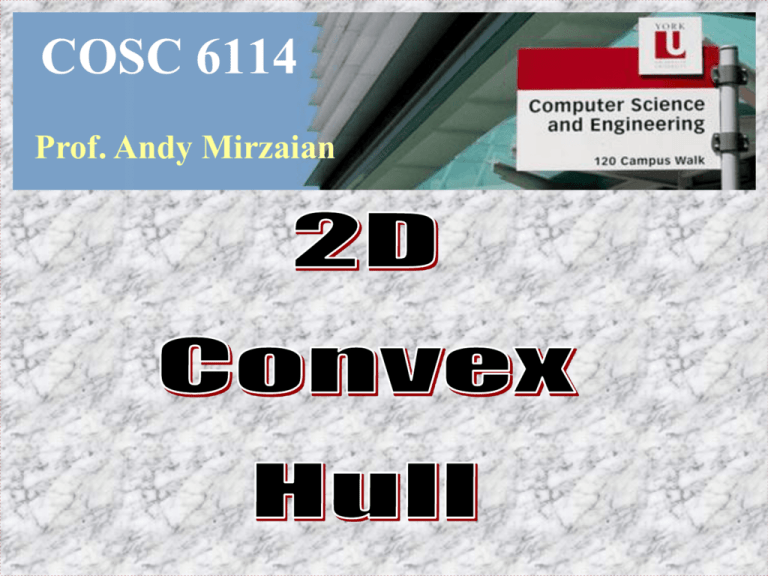
COSC 6114
Prof. Andy Mirzaian
TOPICS
Affine Hull
Convex Hull
2D Convex Hull
Static Algorithms
Applications
Dynamic Algorithms
Affine HULL
Given S d
(d = 1,2,3, …)
Affine-Hull of S:
aff(S) = the set of all affine combinations of points in S
= the smallest “flat” that contains S
(flat = any set affine equivalent to k , for some k d.)
Examples:
aff(p1, p2) = the line p1p2 ( single point if the two coincide).
aff(p1, p2 , p3) = the plane through p1, p2 , p3. (line, if the 3 points collinear).
In general: dimension k of aff(p1, p2 , … , pn)
= rank of matrix [p2-p1, p3-p1 , … , pn-p1].
CONVEX HULL
Given S d
(d = 1,2,3, …)
Convex-Hull of S:
CH(S) = the set of all convex combinations of points in S
= the smallest convex set that contains S
= the intersection of all convex sets that contain S
The rubber-band analogy: Place a rubber-band around S and let it tighten.
Example 1: |S| infinite
Example 2: |S| finite
The Convex Hull Problem
Given a set S={p1,p2, … , pn} of n points in d , compute CH(S).
In general, CH(S) will be a convex polytope whose vertices are
a subset of S, called extreme points of S.
Dimension d=1:
trivial, O(n) time.
Dimenension d=2:
min
max
extreme point
supporting line
2D Convex Hull: Early development
Caratheodory’s Theorem: p is NOT an extreme point
p is a convex-combination of up to 3 (=d+1) other points.
An O(n4) time algorithm:
–Eliminate non-extreme points by checking each 4-point subset.
–Then order the extreme points around the convex-hull. (How?)
p
O(n4) is too slow.
2D CH: An O(n3) time algorithm
Algorithm CH(P)
•E
(* edge-list of CH(P) *)
• for all ordered pairs (p,q) PP, p q do
supporting true
•
for all points r P-{p,q} do
•
if r is on the right side of pq then supporting false
•
if supporting then add directed edge pq to E
• From the (un-ordered) edge-list E, construct the list of vertices of CH(P)
in CCW order in O(n) time. (How?)
•
end
O(n3)
q
still too slow!
p
QUICK HULL
S
(similar to QuickSort - see AAW)
QUICK HULL
S2
leftmost
B
rightmost
A
S1
A & B are extreme points (admit vertical supporting lines)
S1 points to the right of AB
S2 points to the right of BA
Initialize CH to AB followed by BA. (uninflated baloon)
Call FindHull (S1,A,B) and FindHull(S2, B,A)
FindHull(P,A,B):
• If P is empty, then return.
• Find (extreme) point CP orthogonally farthest from AB.
• CH update: replace AB with AC followed by CB. (inflate baloon)
• Partition P-{C} into Q0, Q1, Q2 as shown.
• Discard Q0 inside triangle ABC (by Caratheodory).
• Recursively call FindHull(Q1,A,C) and FindHull(Q2,C,B).
B
max
A
Q0
Q2
supporting line at C
Q1
C
(C is extreme point)
QuickHull animation
T(n) = Time Complexity of FindHull(P,A,B),
where n=|P|
- Find C, Q0, Q1, Q2: O(n) time
- FindHull(Q1,A,C): T(q) time.
( | Q1| = q )
- FindHull(Q2,C,B): T(n-1-q) time.
( | Q2| n-1-q )
Worst Case:
T(n) = max { T(q) + T(n-1-q) + O(n) | 0 q n-1 }
= T(0) + T(n-1) + O(n)
= O(n2)
Average Case:
On many realistic point distributions
Avg[T(n)] = O(n) or close to it.
Algorithm Jarvis’ March [1973]
{ gift-wrapping method, generalizes to higher dimensions}
Step 1: Let p1 be the point with minimum y-coordinate (lex.)
Step 2: Anchor ray at current point and rotate to next anchor point.
Repeat.
p4
p3
p5
p2
p1
Ray
Output-sensitive: O(nh) time.
n = # input points, h = # hull vertices (output size)
(3 h n if n 3 and not all points collinear)
Worst-case: O(n2) time.
Algorithm Graham-Scan (p1 .. pn)
[1972]
Step 1: Polar-Sort p1 .. pn :
Find a lexicographically min point among pi
(e.g., leftmost-lowest point) and swap with p1.
Sort p2 .. pn by their polar angle of rays p1 pi , i=2..n.
(Use –test to simulate comparisons in the sorting.)
p7
p6
p4
p5
p3
p2
p8
p1
O(n)
Step 2: Stack S (p2 , p1) (* p1 at the bottom *)
for i 3 .. n do
while not CW(pi, Top(S), 2ndTop(S)) do POP(S)
PUSH(pi,S)
end-for
O(n)
Step 3: return S
(* vertices of CH(p1 .. pn ) in CCW order *)
Graham-Scan : a snapshot of step 2
pi
p5
p6
p4
p3
p
7
p2
pi
p7
p6
p5
p4
p3
p2
p1
Stack S
p1
(n log n) Lower Bound for 2D Convex Hull Problem
Reduction from Sorting (using the Lifting Method)
Sort: X = (x1, x2, … , xn )
(n given real numbers on the x-axis)
Step 1: P {p1, p2 , … , pn},
Step 2: Compute CH(P)
y
where pj = (xj , xj2), j=1..n
pj
CH ( p1, … , pn )
y = x2
parabola
(convex)
xj
x
Step 3: Sorted(X) can be obtained from CH(P) in O(n) added time.
(n log n) = O(n) + T(n) + O(n) T(n) = (n log n).
Algorithm Divide-&-Conquer 2D Convex-Hull:
•
•
x-sort the given points p1, p2, … , pn (lexicographically).
Call CH({p1, p2, … , pn }).
Procedure CH(S):
• Base: if |S| 3 then return trivial answer.
T(n) =
O(1)
or
•
Divide: Partition S into two (almost) equal halves
L and R around the x-median of S.
O(n)
+
•
Conquer: Recursively call CH(L) and CH(R).
2T(n/2)
+
•
Merge: Compute common upper/lower bridges
of CH(L) and CH(R), and obtain CH(S).
(See next page.)
T(n) = 2 T(n/2) + O(n) = O( n log n).
O(n)
Divide-&-Conquer algorithm:
CH(R)
CH(L)
n/2
n/2
x-median
Merge: How to compute the upper-bridge in O(n) time:
CW
CCW
l = max x
in CH(L)
r = min x
in CH(R)
Other 2D Convex-Hull Algorithms: (Lecture Notes 1 & 2)
Melkman [1987]: Convex-Hull of a simple polygon in linear time.
Kirkpatrick-Seidel [1986]:
2D convex-hull of n points in O(n log h) time.
n = input size
h = output size
3h n
(i.e., # convex hull vertices)
(if n 3 and not all points are collinear)
[This is a good example of a prune-&-search algorithm.]
Melkman’s Linear-Time algorithm for CH of Simple Polygon
Input: Simple polygon P = ( p1 , p2 , … , pn )
Output: CH(P)
Time: O(n)
Method: Incrementally maintain CH(p1 , p2 , … , pi ) in a
circular deque D=(vt,vt-1,…,vb+1,vb) (top vt= vb bottom)
Algorithm Convex-Hull ( P )
D (p2 , p1 , p2)
(* CH(p1 , p2) *)
for i 3 .. n do
if pi is outside angle vt-1vtvb+1 then do
while pi is left of vbvb+1 do PopBottom(D)
while pi is right of vtvt-1 do PopTop(D)
PushBottom(pi,D)
PushTop(pi,D)
end-if
end-for
return D
Case 1: pi is outside angle vt-1vtvb+1
vb+1
pi
vt=vb
vt-1
Case 2: pi is inside angle vt-1vtvb+1 pi is not an extreme point
P is simple
non-crossing chains between vt-1 & vb+1 and between vt & pi
pi CH(p1 .. pi-1).
vb+1
pi
vt=vb
vt-1
Kirkpatrick-Seidel’s O(n log h) time 2D CH algorithm
IDEA: turn divide-&-conquer into conquer-then-divide!
It finds the upper/lower bridge between the halves L and R
in O(n) time, without yet knowing CH(L) and CH(R).
(Must also avoid O(n log n) time pre-sorting on x-axis.)
p
Upper-hull
q
vertical
edge
L
Lower-hull
xmin
xmax
xmed
R
How to find Upper-Hull of P:
P = LR, |P| = n, |L| |R| n/2, upper-bridge pq
L’ L, R’ R (points “under” the bridge pq ignored)
h = # upper-hull vertices of P
h1 = # upper-hull vertices of L’
h2 = # upper-hull vertices of R’
FACT: h = h1 + h2
q
p
divide-&-conquer wastes
computation on points in this
area
R’
L’
L
R
xmed
T(n,h)
Algorithm Upper-Hull (P)
O(1)
•
if |P| 2 then return the obvious answer.
O(n)
•
•
xmed median x-coordinates of points in P.
Partition P into L & R of size n/2 each around xmed.
O(?)
•
Find upper-bridge pq of L & R, pL, qR.
O(n)
•
•
L’ { lL | xl xp }
R’ { rR | xr xq }
•
•
LUH Upper-Hull (L’)
RUH Upper-Hull (R’)
•
return ( LUH , pq , RUH )
T(n/2,h1)
T(n/2,h2)
O(n)
Recursive calls
(* upper-hull edge sequence *)
Key idea: compute upper-bridge of L & R in O(n) time (next slides).
Define: T(n,h) = time complexity of Upper-Hull(P)
where n = |P| and h = # upper-hull vertices.
THEOREM: T(n,h) = O( n log h ).
Proof: Algorithm gives the recurrence:
T(n,h) cn + max { T(n/2 , h1) + T(n/2,h2) | h1+h2=h } if h > 2
T(n,h) cn if h 2.
Induction hypothesis on h: T(n,h) c n log 2h, h 1.
Basis (h=1,2): T(n,h) cn cn log 2h.
Induction Step (h>2):
T(n,h) cn + max { c(n/2) log (2h1)+ c(n/2) log (2h2) | h1+h2=h }
= cn + max { c(n/2) log (2h1*2h2) | 2h1+2h2=2h }
= cn + c(n/2) log (h*h)
= cn log 2h
QED
How to find the upper-bridge of L & R in O(n) time?
Find * , * to
minimize y*=*a + *
subject to:
xi * + * yi pi P = LR
p*
q*
L
x=a
R
This is a 2-variable Linear Program (* , *).
* = slope and * = y-intercept of the upper-bridge.
p
q
R
L
Choose any slope :
Case 1: slope(pq) < * <
Case 2: slope(pq) > * >
Case 3: slope(pq) = * =
p & q = tangency points of -slope upper-tangents to L & R, respectively
Prune-&-Search on :
• Partition LR into n/2 arbitrary pairs (r,s), xr xs
• median slope of these n/2 pair slopes(rs)
• In cases 1 & 2 we can PRUNE n/4 points:
• Case 1: slope(rs) (holds for n/4 pairs (r,s))
s
slope(rs) > *
upper-bridge cannot pass through r. Prune r.
r
*
• Case 2: slope(rs) (holds for n/4 pairs (r,s))
s
slope(rs) < *
r
upper-bridge cannot pass through s. Prune s.
*
• Case 3: slope(pq)= *. We have found the upper-bridge.
Prune-&-Seach Bridge Finding:
• Each prune-&-search iteration takes linear time on the points not yet pruned.
• It eliminates at least a quarter of the points (or finds the optimum slope).
• If we start with n points, first iteration eliminates at least n/4 points.
So, at most 3n/4 points remain. Then we iterate on the prune-&-search.
• Total bridge-finding time
= O( n + (¾) n + (¾)2 n + (¾)3 n + … ) = O(n).
CONCLUSION:
Upper-Bridge (and Lower-Bridge) finding takes O(n) time.
Kirkpatrick-Seidel’s CH algorithm takes O(n log h) time.
Higher Dimensional Convex Hull
Convex hull of n points in 3D can also be computed in O(n log n) time,
e.g., by the divide-&-conquer method.
In general, the convex hull of n points in d>1 dimensions
can be computed in O( n log n + nd/2 ) time.
These will be discussed later in the course.
Some Applications of Convex Hull
• Diameter farthest pair
• Linear separability
• Convex Layers:
• Other related problems: Smallest enclosing circle
O(n) time by Megiddo-Dyer’s prune-&-search technique
The Farthest Pair among n points
Given a set S = { p1, p2, … , pn } on the plane,
Find the farthest pair, i.e., a pair (pi,pj) in S such that
d(pi,pj) d(pt,pk) pt,pk S.
Euclidean distance: d(pi,pj) = ((xi –xj)2 + (yi –yj)2 )1/2
FACT: Farthest pair of S is realized by a pair of vertices of CH(S).
Proof:
pi
pi
x
pk
pj
pj
d(pi,pj) d(pi,x) < d(pi,pk) , a contradiction.
Algorithm DIAMETER (p1, p2, … , pn )
Step 1: P CH(p1, p2, … , pn )
Step 2: Compute diameter of P by the rotating calipers method.
O(n log n)
O(n)
The rotating calipers method:
p
q
Definition: Antipodal Pair
(p,q) is an antipodal pair if there are a pair of parallel supporting lines of CH(S)
Through p and q that sandwich CH(S) in between.
FACT: The farthest pair is one of the antipodal pairs.
CLAIM: There are 2n antipodal pairs & they can all be found in O(n) time.
Proof:
p3
l
l
p4
p1p2
p2
p2p3
p1
l’
p5
p1
p3p4
l’
p5p1
p4
p4p5
THEOREM:
Farthest pair among n points in the plane can be found in O(n log n) time.
A
This is worst-case optimal: reduction from set disjointness
B
Linear Separability
B
A
A & B are linearly separable CH(A) & CH(B) have disjoint interiors
O(n log n) time.
Fastest result: O(n) time by prune-&-search [Exercise]
Convex Layers
O(n2) time: by repeated application of Jarvis’ March.
Fastest result: O(n log n) time
Chazelle[1985], “On the convex layers of a planar set”,
IEEE Transactions on Information Theory, vol IT-31, No. 4, pp: 509-517.
Dynamic Convex Hull
Dynamic Convex Hull Problem
Maintain (the convex hull of) a finite set S d (d=2,…)
under the following operations:
– Insert
a given point p into S.
– Delete a specified point p from S.
– Query: is a given point q inside CH(S)?
– Report CH(S).
Semi-Dynamic 2D CH: Insertion only
F. Preparata [1979], “An optimal real time Algorithm for planar
convex hulls,” Comm. ACM 22(7):402-405.
– Insertion time: O(log n)
– Query time:
O(log n)
– Memory space: O(n)
Solution: Maintain upper/lower hulls separately, each as a sorted chain of points in
a dictionary with split and join operations (e.g., red-black, 2-3-4, AVL, or splay tree).
p
Search primitives:
reflex
p
join
split
inflex
supporting p
p
Semi-Dynamic 2D CH: Deletion only
B. Chazelle [1985],
“On the convex layers of a planar set”,
IEEE Trans. Info. Theory IT-31(4):509-517.
J. Hershberger, S. Suri [1992],
“Applications of a semi-dynamic convex hull algorithm,”
BIT 32(2):249-267.
– Deletion:
O(log n) amortized time.
– Memory space: O(n)
Dynamic 2D CH
• [PrS85] Preparata-Shamos (book) Section 3.3.7
• M.H. Overmars, J. van Leeuwen [1981],
“Maintenance of configurations in the plane,”
JCSS 23:166-204.
Maintain both Upper and Lower Hull.
• Insert:
O(log2 n) time
• Delete:
O(log2 n) time
• Query:
O(log n) time
• CH Report:
O(h) time.
• Space:
O(n)
points
resurface
• G. Brodal, R. Jacob [FOCS2002], “Dynamic planar convex hulls”.
Improves Insert & Delete to O(log n) amortized time.
• LN3: Demaine-Patrascu [SoCG2007].
delete
Overmars - van Leeuwen
• Maintain both U-hull and L-hull separately.
U-hull
• All points of S are stores, in x-sorted order left to right, at the
leaves of a search structure, one point per leaf node.
• Each internal node represents the upper-hull of the set of its
leaf descendent nodes. (Explanation follows.)
Overmars - van Leeuwen
• U-hull: 2-level dynamic data structure.
q
v
p
U21
U11
x(v), J(v), Q(v)
U22
U12
U12
U1
U21
U2
x(v)
U(v) = (U11 , pq , U22)
upper-hull of descendents of v.
J(v) = index of p in U(v)
Q(v) = Secondary structure at v.
Portion of U(v) that does not
appear in parent of v.
Example:
7,3,(11,4,1,5,12)
9,2,(7)
10,1,(2)
1,1,
4,2,(3,9)
11,1,
8,1,
2,1,(10)
3,1,
11
4
3
9
5,1,(8)
1
7
2
10
5
8
data structure
6,1,(6)
6
12
1
5
hull tree
2
4
7
12
8
3
6
10
11
9
Example: Insert point 13
7,3,(11,4,1,13,12)
9,2,(7)
13,2,(2)
1,1,
4,2,(3,9)
11,1,
10,1,(10)
3,1,
11
4
3
9
8,1,
2,1,
1
7
2
10
13
5,1,(8)
5
8
data structure
6,1,(6)
6
12
13
1
5
hull tree
2
4
7
12
8
3
6
10
11
9
Bridging: Given U1 & U2 separated by vertical line x(v), find bridge p*q*.
q*
p*
(U1 & U2 are given as dictionaries)
U2
U1
x(v)
q
reflex
p
inflex
p q
p
reflex
U1
U2
U1
supporting
q
q
p
U2
U1
U2
q
q
inflex
?
p
U1
U2
q
p
p
U1
U1
U2
U2
q
p
supporting
U1
q
p
U2
U1
q
U2
p
U1
U2
Bridging: How to resolve the inflex-inflex Case:
u
r
w
q
p
bridge must intersect
this shaded area
U2
U1
x(v)
Secondary structure Q(v), at each node v, is implemented by a dictionary
(as in [Preparata’79] insert-only semi-dynamic CH algorithm).
Insertion algorithm:
• Follow the search path down (on the primary structure) and do de-bridging.
• Insert the new point at a new leaf node at the end of the search path.
• Back up the same path and do bridging.
O(log2 n) time: O(log n) time per primary node on the search path for
O(log n) nodes on the search path.
De-bridging:
root
v
q
p
q
p
x(v)
Deletion algorithm: Left as exercise.
[Balancing/rotation operations do not add extra asymptotic cost.]
Exercises
1.
[CLRS, Exercise 33.1-5, page 939] Prove or disprove: a sequence P= p0, p1, …, pn-1 of n
points in the plane forms the boundary of a convex polygon if and only if , for i = 0..n-1 (mod
n index arithmetic), (pi-1, pi, pi+1) are all positive or all negative, i.e., either all are left turns
or all are right turns.
2.
Convex hull of sorted points: Show that the convex hull of a set P of n points in the plane can
be computed in O(n) time if the points in P are already sorted on their x-coordinates. Prove the
correctness and time complexity of your algorithm.
3.
[CLRS, Exercises 33.3-5 & 33.3-6, page 957] On-line convex hull: We are given a set P of
n points in the plane, one point at a time on-line. Update CH(P) after receiving each point
(a) Design and analyze a simple O(n2) time algorithm for this problem.
(b) Design and analyze an O(n log n) time algorithm for this problem.
4.
Convex hull in integer grid: Given a planar set P of n points with coordinates as positive
integers at most nk, where k is some constant, show CH(P) can be constructed in O(n) time.
5.
Convex hull of unit circles: Let S be a set of n given, possibly intersecting, unit circles (i.e.,
all with radius 1) on the plane. The boundary of CH(S) consists of line-segments and some
circular arcs that are pieces of circles in S.
(a) Show that each circle can contribute at most one circular arc to the boundary of CH(S).
(b) Let C be the set of n centers of the circles in S. Show that circle AS contributes an arc to
the boundary of CH(S) if and only if the center of A is an extreme point of C.
(c) Design and analyze an efficient algorithm that outputs the boundary of CH(S). [The output
should be in the form of a finite closed chain of line segments and circular arcs.]
6.
[CLRS, Exercise 3.1-4, page 939] Show how to determine in O(n2 log n) time whether any 3
points in a set of n points in the plane are collinear.
7.
Given a set P of n points in the plane, construct a simple polygon with P as its vertex set.
(a) Show the (n log n) lower bound on the worst-case time complexity of this problem.
(b) Design an O(n log n) time algorithm for this problem.
8.
Show that any set S of at least d+2 points in d can be partitioned into two nonempty subsets
A and B such that CH(A) CH(B) . [Hint: consider linear combinations of points in S.]
9.
Given a set P of n points and another point q, all in the plane, design an O(n) time algorithm
to decide whether q is in CH(P). [Note: CH(P) is not given.]
10. We are given a set P of n points, and a triangular area T specified by its three vertices
T = (t1 , t2 , t3), all in the plane.
(a) Design and analyze an O(n)-time algorithm to decide whether CH(P), the convex hull
of P (interior as well as boundary), intersects with triangle area T.
(b) Consider the modified version of the problem in part (a), where we want to decide
whether the boundary of CH(P) intersects area T. Design and analyze an efficient
algorithm for this problem.
11. Polygon distance: Given two disjoint convex polygons P and Q in the plane, design an
efficient algorithm to determine the closest pair of points between P and Q.
(Note these points may not necessarily be vertices.)
12. Linear & Circular Separability: Use prune-&-search to show the linear separability
problem can be solved in O(n) time. How about circular separability (a circle that contains
one set inside, the other outside)?
13. Linear Regression: Given a set P of n points in the plane, determine a non-vertical line L
such that the largest vertical distance between any point of P to L is minimized.
Show an O(n) time solution to this problem using prune-&-search.
L
END
